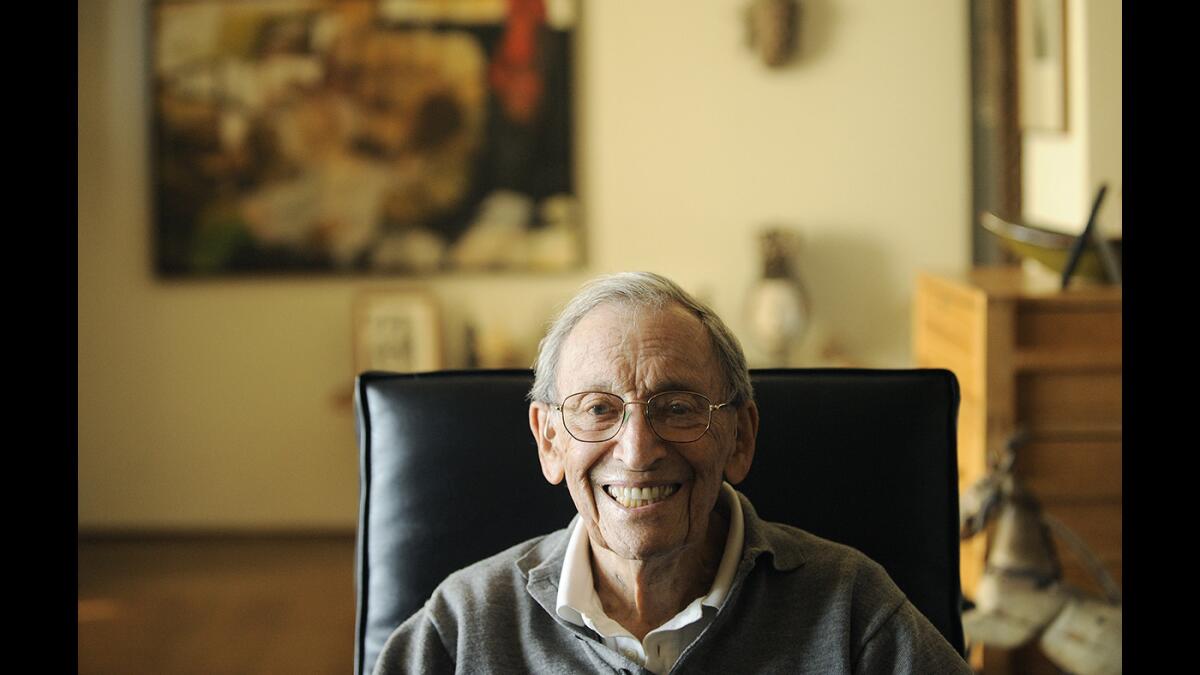Ackermans’ Midcentury style back in demand with book, film, events

- Share via
Prolific Midcentury designers Jerome and Evelyn Ackerman are the focus of a new flurry of attention. The Ackermans worked in a variety of media, including ceramics, mosaics, tapestries and woodcarvings, introducing items into the market starting in 1953. Evelyn Ackerman died two years ago, but Jerome, known as Jerry by most, is enjoying a blitz of recognition that includes a recent book, a short film made by the Nartonis Project and an installation of Ackerman-carved doors in the Palm Springs Eisenhower Health Center building designed by Donald Wexler.
------------
FOR THE RECORD:
Jerome and Evelyn Ackerman: In the Feb. 7 Saturday section, an article about Midcentury artists and designers Jerome and Evelyn Ackerman said that they began introducing wares into the market in the 1940s. Their designs entered the market in 1953. —
------------
During Modernism Week in Palm Springs, Ackerman, 95, plans to make an appearance Feb. 14 at “Masters of Midcentury California Design: The Story of Evelyn and Jerome Ackerman,” which highlights their role in shaping the aesthetic of California Midcentury Modernism. The event will feature a panel of writers, curators, historians and gallery directors; and a lecture by Dan Chavkin and Lisa Thackaberry, authors of “Hand-in-Hand: Ceramics, Mosaics, Tapestries, and Wood Carvings, and Hardware by the California Mid-Century Designers Evelyn and Jerome Ackerman.” It also includes the premiere of “In Tandem: The Life and Work of Jerry and Evelyn Ackerman,” the film made by Margaret Halkin and Katie Nartonis, and the unveiling of Ackerman-designed doors to be installed at the medical center.
At his home in Culver City recently, surrounded by their work, Ackerman spoke lovingly about Evelyn, describing their years together, how they worked together and supported each other. “Like this,” he said interlacing his wrinkled fingers. “We were melded together.”
“We really pushed each other along,” Ackerman said. If they hadn’t met, he would have been a potter, he said, and that would have been it. But what they did together was far more exciting. “I felt that what Evie did was pretty damn amazing and what we did together was even more amazing and we achieved it.”
“Ultimately the story of Evelyn and Jerry is a love story,” said Jeff Weyant, who organized the event at Modernism Week and has been involved in acquiring an Ackerman collection for the medical center. “The power of their love was procreative — their incredible daughter, Laura — but, unlike many couples, their love was powerfully creative.” He mentioned a retrospective exhibition of their work at the Mengei in San Diego in 2009, curated by Modernism Week panelists Dale Carolyn Gluckman and Jo Lauria, as a testimony to the creative power of their love. “Our Modernism event will celebrate this love and its creative force and significant contribution to California Midcentury Modern design and to the world, on Valentine’s Day no less.”
“They don’t make people like Jerry anymore,” said author Thackaberry, a former editor at the Los Angeles Times Magazine. Years ago, she and coauthor Chavkin visited the Ackerman home to see if a tapestry made by Chavkin’s grandmother came from a kit designed by the Ackermans. “It wasn’t an Ackerman,” Thackaberry said, “but when we walked into their home and saw all the work, it was immediate: We knew we wanted to work on a book.” The book, published by Pointed Leaf Press in November, has a foreword by potter and interior designer Jonathan Adler and an introduction by Los Angeles Times contributor David A. Keeps.
Both authors were struck by the meticulously organized archives the Ackermans kept of their work, ideas, sketches and studies, and the magazines and newspapers in which their work appeared.
Why wasn’t there a book or a film earlier? According to Katie Nartonis, 20th century design specialist for Heritage Auctions and one of the filmmakers, the Ackermans have been the best-kept secret in California Modernism, although their work was a top example of the style, with their use of organic forms to create pieces that were highly functional, colorful and ultimately optimistic in spirit. “They weren’t a household name; they were a household style. Often people recognized the work but didn’t know who made it. They definitely flew under the radar for a long time.”
And why were they under the radar? “We were busy working,” Ackerman said.
Glancing around his home, Ackerman pointed to various pieces the couple created, discussing their original inspiration at Alexander Girard’s “An Exhibition for Modern Living,” the long hours pieces sometimes took and the energy that came from coming up with a new idea or a new direction. On the coffee table was the book “Hand-In-Hand.”
He’d signed 100 copies of it at a recent party hosted by Gerard O’Brien at Reform Gallery. “It was wild,” Ackerman said. “I didn’t expect there would be so many people, but they just kept coming.”
“Now see, we set out to do it in 1949, walking out of the Detroit Institute of Arts, and here we are now, walking out of the book. It’s just me now. But it’s all our work, and I know she’s here with me, enjoying this too.”
More to Read
The biggest entertainment stories
Get our big stories about Hollywood, film, television, music, arts, culture and more right in your inbox as soon as they publish.
You may occasionally receive promotional content from the Los Angeles Times.










